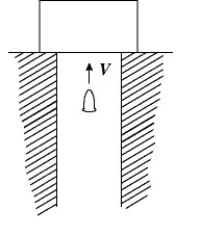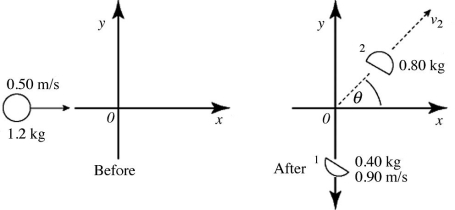A) 216.9° from the x-axis
B) 219.8° from the x-axis
C) 36.9° from the x-axis
D) 39.9° from the x-axis
E) 39.8° from the x-axis
Correct Answer

verified
Correct Answer
verified
Multiple Choice
In a perfectly ELASTIC collision between two perfectly rigid objects
A) the momentum of each object is conserved.
B) the kinetic energy of each object is conserved.
C) the momentum of the system is conserved but the kinetic energy of the system is not conserved.
D) both the momentum and the kinetic energy of the system are conserved.
E) the kinetic energy of the system is conserved, but the momentum of the system is not conserved.
Correct Answer

verified
Correct Answer
verified
Multiple Choice
A block of mass m = 8.40 kg, moving on a horizontal frictionless surface with a speed 4.20 m/s, makes a perfectly elastic collision with a block of mass M at rest. After the collision, the 8.40 block recoils with a speed of 0.400 m/s. In the figure, the blocks are in contact for 0.200 s. The magnitude of the average force on the 8.40-kg block, while the two blocks are in contact, is closest to 
A) 193 N.
B) 185 N.
C) 176 N.
D) 168 N.
E) 160 N.
Correct Answer

verified
Correct Answer
verified
Multiple Choice
A 15-g bullet is shot vertically into an 2-kg block. The block lifts upward 8.0 mm (see the figure) . The bullet penetrates the block and comes to rest in it in a time interval of 0.0010 s. Assume the force on the bullet is constant during penetration and that air resistance is negligible. The initial kinetic energy of the bullet is closest to 
A) 21 J.
B) 14 J.
C) 10 J.
D) 0.0012 J.
E) 0.16 J.
Correct Answer

verified
Correct Answer
verified
Multiple Choice
A 2.3-kg object traveling at 6.1 m/s collides head-on with a 3.5-kg object traveling in the opposite direction at 4.8 m/s. If the collision is perfectly elastic, what is the final speed of the 2.3-kg object?
A) 0.48 m/s
B) 7.1 m/s
C) 3.8 m/s
D) 4.3 m/s
E) 6.6 m/s
Correct Answer

verified
Correct Answer
verified
Multiple Choice
In the figure, determine the character of the collision. The masses of the blocks, and the velocities before and after are given. The collision is 
A) perfectly elastic.
B) partially inelastic.
C) completely inelastic.
D) characterized by an increase in kinetic energy.
E) not possible because momentum is not conserved.
Correct Answer

verified
Correct Answer
verified
Multiple Choice
Consider two less-than-desirable options. In the first you are driving 30 mph and crash head-on into an identical car also going 30 mph. In the second option you are driving 30 mph and crash head-on into a stationary brick wall. In neither case does your car bounce off the thing it hits, and the collision time is the same in both cases. Which of these two situations would result in the greatest impact force?
A) hitting the other car
B) hitting the brick wall
C) The force would be the same in both cases.
D) We cannot answer this question without more information.
E) None of these is true.
Correct Answer

verified
Correct Answer
verified
Multiple Choice
A 1.2-kg spring-activated toy bomb slides on a smooth surface along the x-axis with a speed of 0.50 m/s. At the origin 0, the bomb explodes into two fragments. Fragment 1 has a mass of 0.40 kg and a speed of 0.90 m/s along the negative y-axis. In the figure, the energy released by the explosion is closest to 
A) 0.20 J.
B) 0.24 J.
C) 0.28 J.
D) 0.32 J.
E) 0.36 J.
Correct Answer

verified
Correct Answer
verified
Multiple Choice
A small car has a head-on collision with a large truck. Which of the following statements concerning the magnitude of the average force due to the collision is correct?
A) The truck experiences the greater average force.
B) The small car experiences the greater average force.
C) The small car and the truck experience the same average force.
D) It is impossible to tell since the masses are not given.
E) It is impossible to tell since the velocities are not given.
Correct Answer

verified
Correct Answer
verified
Multiple Choice
On a smooth horizontal floor, an object slides into a spring which is attached to another mass that is initially stationary. When the spring is most compressed, both objects are moving at the same speed. Ignoring friction, what is conserved during this interaction?
A) momentum and mechanical energy
B) momentum only
C) kinetic energy only
D) momentum and kinetic energy
E) momentum and potential energy
Correct Answer

verified
Correct Answer
verified
Multiple Choice
Two objects of the same mass move along the same line in opposite directions. The first mass is moving with speed v. The objects collide, stick together, and move with speed 0.100v in the direction of the velocity of the first mass before the collision. What was the speed of the second mass before the collision?
A) 1.20v
B) 10.0v
C) 0.900v
D) 0.800v
E) 0.00v
Correct Answer

verified
Correct Answer
verified
Multiple Choice
A firecracker breaks up into several pieces, one of which has a mass of 200 g and flies off along the x-axis with a speed of 82.0 m/s. A second piece has a mass of 300 g and flies off along the y-axis with a speed of 45.0 m/s. What are the magnitude and direction of the total momentum of these two pieces?
A) 361 kg ∙ m/s at 56.3° from the x-axis
B) 93.5 kg ∙ m/s at 28.8° from the x-axis
C) 21.2 kg ∙ m/s at 39.5° from the x-axis
D) 361 kg ∙ m/s at 0.983° from the x-axis
E) 21.2 kg ∙ m/s at 56.3° from the x-axis
Correct Answer

verified
Correct Answer
verified
Multiple Choice
A 1.0-kg block and a 2.0-kg block are pressed together on a horizontal frictionless surface with a compressed very light spring between them. They are not attached to the spring. After they are released and have both moved free of the spring
A) the lighter block will have more kinetic energy than the heavier block.
B) the heavier block will have more kinetic energy than the lighter block.
C) both blocks will both have the same amount of kinetic energy.
D) both blocks will have equal speeds.
E) the magnitude of the momentum of the heavier block will be greater than the magnitude of the momentum of the lighter block.
Correct Answer

verified
Correct Answer
verified
Multiple Choice
A pool player is attempting a fancy shot. He hits the cue ball giving it a speed of 5.57 m/s and directs its center on a path tangent to the surface of the target ball having the same mass as the cue ball. After the collision (on a frictionless table) the initially-stationary ball moves with a speed of 4.82 m/s. After the collision, the new speed of the cue ball and the relative direction of the balls are closest to
A) 2.79 m/s, at 90° to each other.
B) 2.79 m/s, at 60° to each other.
C) 8.34 m/s, at 90° to each other.
D) 8.34 m/s, at 60° to each other.
Correct Answer

verified
Correct Answer
verified
Multiple Choice
As a tile falls from the roof of a building to the ground its momentum is conserved.
A) True
B) False
Correct Answer

verified
Correct Answer
verified
Multiple Choice
A shell explodes into two fragments, one fragment 25 times heavier than the other. If any gas from the explosion has negligible mass, then
A) the momentum change of the lighter fragment is 25 times as great as the momentum change of the heavier fragment.
B) the momentum change of the heavier fragment is 25 times as great as the momentum change of the lighter fragment.
C) the momentum change of the lighter fragment is exactly the same as the momentum change of the heavier fragment.
D) the kinetic energy change of the heavier fragment is 25 times as great as the kinetic energy change of the lighter fragment.
E) the kinetic energy change of the lighter fragment is 25 times as great as the kinetic energy change of the heavier fragment.
Correct Answer

verified
Correct Answer
verified
Multiple Choice
Two ice skaters push off against one another starting from a stationary position. The 45.0-kg skater acquires a speed of 0.375 m/s. What speed does the 60.0-kg skater acquire? Assume that any other unbalanced forces during the collision are negligible.
A) 0.500 m/s
B) 0.281 m/s
C) 0.375 m/s
D) 0.750 m/s
E) 0.000 m/s
Correct Answer

verified
Correct Answer
verified
Multiple Choice
A 5.00-kg ball is hanging from a long but very light flexible wire when it is struck by a 1.50-kg stone traveling horizontally to the right at 12.0 m/s. The stone rebounds to the left with a speed of 8.50 m/s, and the ball swings to a maximum height h above its original level. The value of h is closest to
A) 0.0563 m.
B) 1.10 m.
C) 1.93 m.
D) 2.20 m.
E) 3.69 m.
Correct Answer

verified
Correct Answer
verified
Multiple Choice
A billiard ball traveling at 3.00 m/s collides perfectly elastically with an identical billiard ball initially at rest on the level table. The initially moving billiard ball deflects 30.0° from its original direction. What is the speed of the initially stationary billiard ball after the collision?
A) 2.00 m/s
B) 0.866 m/s
C) 1.50 m/s
D) 2.59 m/s
E) 0.750 m/s
Correct Answer

verified
Correct Answer
verified
Multiple Choice
A 620-g object traveling at 2.1 m/s collides head-on with a 320-g object traveling in the opposite direction at 3.8 m/s. If the collision is perfectly elastic, what is the change in the kinetic energy of the 620-g object?
A) It loses 0.23 J.
B) It gains 0.69 J.
C) It loses 0.47 J.
D) It loses 1.4 J.
E) It doesn't lose any kinetic energy because the collision is elastic.
Correct Answer

verified
Correct Answer
verified
Showing 21 - 40 of 43
Related Exams